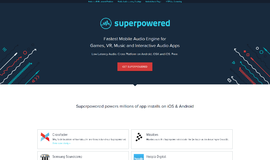The State of Web Development for 2016
There were many bold predictions being made on what web development trends we could expect for 2016. With the Internet of Things (IoT ), wearable technology, and widespread use of mobile devices, how can websites and web applications adapt to this environment? And will these new developments finally bridge the digital divide between web applications and native apps? Let’s look at the trends getting the most attention now that 2016 is more than halfway through, and at how these trends will shape web development in the future.
Fighting back against ad blocking
In 2015, ad blocking was continuing to grow in popularity and was being celebrated by internet users worldwide—but it also caused widespread panic for website owners everywhere. No wonder—ads maybe annoying but they’re also one of the most reliable and lucrative forms of online monetization available. But as expected, in 2016 we are starting to see more and more websites and applications fighting back against the ad blocking plugins and software; I’m sure most of you have recently seen a “you’re using ad-blocker” popup on a site you’ve visited . And in the recent months, the update to Facebook’s and Google’s data privacy and ad policies may be one of the subtle ways in which these two internet giants are fighting back without directly discouraging the use of ad blockers.
By providing more data for advertisers, they could get past ad blockers by introducing sponsored content or tailored content. But this advantage can only last for so long, so expect to see an arms race between these two factions in the coming years.
Increased Value on Security

With several high profile breaches and data leaks in the past few years, like the Ashley Madison leak, LastPass breach and the LinkedIn hack, the value on security has risen and is starting to be seen as a unique selling point for some enterprise apps.
The best example for this is Telegram, which saw a 60% increase in subscribers in 9 months, reaching the 100 million mark this February thanks to its solid encryption protocol and self-destruct feature for messages. The rising use of and dependence on e-commerce, m-commerce, wearable technology and IoT is another factor contributing to the increasing demand for security, as more and more user data is collected and processed each year.
Utilizing Citizen Development For Enterprise App Development

There’s a serious shortage of technical talent all over the globe which in part is driving the cost of hiring skilled developers. With the explosion of low code or no code platforms in the past few years, businesses are looking into citizen development to help fill in some of the gaps. Skilled developers are still needed but they would mainly be utilized for modification and customization of enterprise apps. The creation of assembly line enterprise apps built with these platforms, accompanied by quick launches and extensive marketing can prove to be profitable if companies can effectively establish a need for these apps and assure product quality.
Hybrid app adoption or cross platform development for enterprise applications
Another way to address the mobile app development skill shortage is through hybrid app or cross platform development. The difference between native apps and mobile web apps is still discernable despite technological advancements but that gap is closing in terms of user experience, performance, design, and features. Other benefits include the reduced cost and multiple device compatibility, including laptops and desktops which are still used by a significant number of users.
Another promising improvement for web development in 2016 is the introduction of progressive web applications by Google. By giving mobile web apps a native look and feel, and making use of mainly HTML, CSS, and Javascript, Google hopes to help reduce the need for native applications, giving web applications more functionality while lowering the entry point for app development.
Real Time Everything

It started with real time analytics. And now we’re seeing a race to launch live stream. Despite being pioneers in the game, Twitter (through Periscope) hasn’t really established a solid foothold in this rich market. This allowed Facebook to quickly match and overtake Twitter, with Instagram, Tumblr and YouTube nipping at their heels.
We’re starting to see the same trend with web development. We’re seeing an increase in the number of services and tools that offer real time visualization, debugging and testing which should help speed up development times and reduce bugs prior to launch.
Browser IDEs and Service Workers
As we’re seeing the rise of real time tools we’re also seeing web developers adopt cloud based or browser based IDEs for app development. In addition to providing real time visualization and testing, browser based IDEs are fast and accessible to a lot of developers. They don’t have a steep learning curve and have large communities providing support. But the biggest selling point for the increased adoption of browser IDEs is flexibility. No need download, you can work and test on any device, and with powerful service workers, applications developed on browser IDE give web apps native features like geofencing, push notifications and more.
The rise of intuitive user interface and the death of responsive design?
Minimalist and responsive design used to be cutting edge and innovative for web applications. But now that they’re considered as industry standards, the focus has shifted to creating advanced platforms to make responsive design faster, more intelligent, and easier to implement. Developments in CSS like the CSS Grid Layout and native CSS variables are expected to help continue the preference for minimalist design by making it easier to build clean and simple interfaces.
We’re also seeing full-screen navigation becoming a standard for web and mobile web applications. With more websites being opened on mobile devices instead of laptops or desktops, it’s becoming imperative for website to become more intuitive for mobile devices. This is also why instead of seeing websites structured to have multiple pages, we’re seeing the rise of single page apps and websites, which are better suited for browsing on mobile devices.
Bots and finally letting go of Flash.

Flash should have been obsolete a long time ago. But one factor that helping to put the final nail in the coffin is the increased demand for security since Flash is notorious for its security vulnerabilities. Replacing flash with Animate CC would hopefully improve overall website security.
We’re also seeing the widespread use of bots in popular platforms like Twitter and Facebook. Although it’s clear that the technology isn’t perfect yet, it won’t be long until we create bots sophisticated enough to understand the nuances of human language and respond intelligently.
Conclusion
The exciting thing about the state of web development during the past few years is the focus on innovation and user experience. We’re seeing developments in frameworks, platforms, design, libraries and tools which have all made the development process faster and easier for programmers in every skill level. We also see security becoming a more important aspect of web development and developers actively addressing vulnerabilities before a web application is even launched.
I think the most exciting trend to come out in 2016 and the one with the potential to significantly gain in important in the next few years is the use and development of bots, artificial intelligence, and intelligent virtual assistants. Right now, these technologies are still in their infancy but are growing more sophisticated as the months pass. I for one am looking forward to seeing what 2017 has in store.
Recent Stories
Top DiscoverSDK Experts

Compare Products
Select up to three two products to compare by clicking on the compare icon () of each product.
{{compareToolModel.Error}}


















{{CommentsModel.TotalCount}} Comments
Your Comment